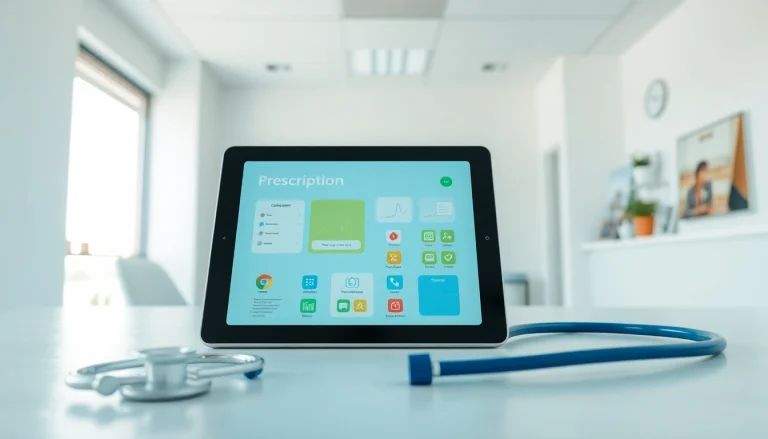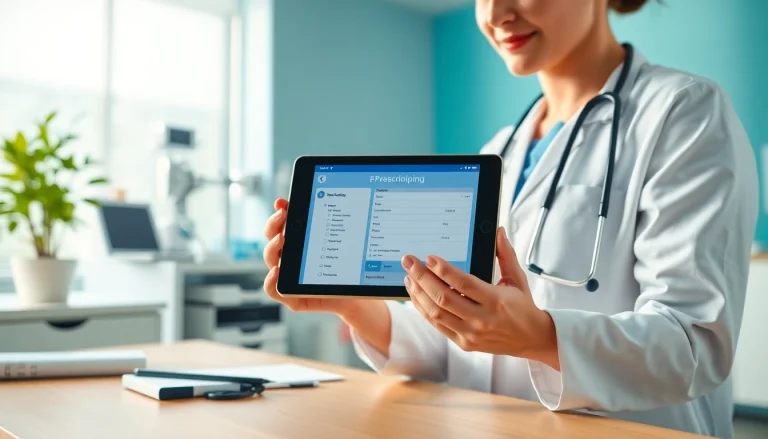
Understanding E-Prescribing: An Overview
E-prescribing, or electronic prescribing, signifies a transformative approach in the healthcare sector, allowing healthcare providers to send prescriptions directly to pharmacies through digital platforms. This modern method simplifies the process of managing patient prescriptions and enhances communication between healthcare providers, patients, and pharmacies. With the rising demand for efficiency and accuracy in patient care, identifying the best eprescription apps becomes paramount for healthcare practitioners looking to upgrade their practices.
What is E-Prescribing?
E-prescribing involves the electronic creation and transmission of prescriptions, replacing traditional paper-based methods. The process allows physicians to write prescriptions via a software application or an electronic health record (EHR) system. These prescriptions are then electronically sent to a designated pharmacy chosen by the patient. This method not only eliminates paper-related errors but also provides immediate access to patient medication histories, which is crucial for making informed clinical decisions.
Benefits of Using Best Eprescription Apps
The utilization of e-prescribing apps offers numerous benefits for both healthcare professionals and patients. Some of the key benefits include:
- Enhanced Prescription Accuracy: E-prescribing reduces the chances of errors due to illegible handwriting or miscommunication, ensuring patients receive the correct medications.
- Increased Efficiency: Healthcare providers can write and send prescriptions in a fraction of the time it takes using traditional methods, allowing them to dedicate more time to patient care.
- Medication Management: E-prescribing apps often come equipped with features that help track patient medication adherence and manage refills, which improve overall health outcomes.
- Streamlined Workflow: Integration with EHR systems allows staff to efficiently manage patient information, prescriptions, and billing processes.
Differences Between E-Prescribing Software and Traditional Methods
The key differentiators between e-prescribing software and traditional prescription methods lie in their functionality and impact on productivity. While traditional methods typically involve handwritten or verbally communicated prescriptions, e-prescribing software automates this task. This shift has profound implications, such as:
- Real-Time Access: E-prescribing provides instant access to patient data, including allergies and current medications, facilitating better clinical decision-making.
- Legible Prescriptions: Unlike handwritten prescriptions, which can be misread, electronically generated prescriptions are clear and precise.
- Automatic Updates: E-prescribing software can alert practitioners about drug interactions or alerts, contributing to safer prescribing practices.
Key Features of Best Eprescription Apps
When searching for the best eprescription apps, several features are essential to consider. The right app not only enhances the workflow of healthcare professionals but also optimizes the patient experience.
User-Friendly Interface
A user-friendly interface is vital for enhancing the efficiency of healthcare providers. An intuitive layout that allows quick navigation and minimal clicks helps reduce the learning curve for staff. The design should ensure that features are readily accessible and that information can be input or retrieved in a timely manner, which is crucial during patient consultations.
Integration with Health Records
Seamless integration with electronic health records (EHR) is another critical feature. This capability allows healthcare providers to access comprehensive patient histories without leaving the e-prescribing application. Integration helps in reducing administrative burdens, ensuring that providers can focus on patient care rather than paperwork. Additionally, a system that interfaces well with pharmacies can reduce the likelihood of errors associated with prescription refills and renewals.
Security and Compliance Standards
Given the sensitive nature of healthcare data, robust security measures are non-negotiable. The best eprescription apps must comply with relevant regulations, such as HIPAA in the United States, ensuring that patient information remains confidential and secure. Features such as data encryption, secure user authentication, and audit trails enhance the security of the prescribing process, giving both healthcare providers and patients peace of mind.
Evaluating the Best Eprescription Apps for Your Practice
Choosing the right e-prescribing app requires careful evaluation. Here are some key considerations to ensure that the selected solution aligns with your practice’s needs.
Assessing User Reviews and Feedback
Understanding other users’ experiences with a given e-prescription app can provide valuable insights. Check professional forums, social media platforms, and review sites to gather honest feedback about the app’s performance, user support, and reliability. Look for patterns in the feedback provided to identify any recurring issues that may be a cause for concern.
Cost Considerations and Pricing Models
Pricing structures for e-prescribing apps can vary significantly, with options ranging from subscription models to pay-per-use systems. Evaluate the total cost of ownership, including setup fees, monthly subscription costs, and additional charges for support or upgrades. A clear understanding of costs will help assess whether the chosen solution provides good value for money in terms of its features and capabilities.
Trial Options and Demonstrations
Many e-prescribing software providers offer trial periods or demonstrations to showcase their applications’ features. Taking advantage of these opportunities allows healthcare providers to assess the app’s usability and functionality before making a financial commitment. Ensure the trial period is long enough to test the app in real-world scenarios to gauge its effectiveness in your practice.
Implementation Steps for Best Eprescription Apps
Successfully implementing an e-prescribing app is a critical step towards modernizing a healthcare practice. Following a structured plan can ensure a smooth transition and maximize the app’s effectiveness.
Preparing Your Practice for Transition
The first step in the implementation process involves preparing your practice for the transition to e-prescribing. This preparation may include assessing current processes, identifying gaps, and ensuring that the intended app will meet your specific needs. Engaging your team in discussions regarding changes enhances buy-in and ensures that everyone is on board with the new processes.
Training Staff on New Systems
An essential phase in the implementation process is training staff on how to use the new e-prescribing app effectively. Staff members should be provided with comprehensive training sessions that cover all facets of the application, including how to enter and transmit prescriptions, access patient records, and utilize additional features. The transition should ideally include both formal training sessions and ongoing support as staff become accustomed to the new system.
Monitoring and Optimizing Usage
Once the application is implemented, establishing performance metrics to monitor its usage is crucial. Tracking metrics such as prescription accuracy, time saved, and user satisfaction can provide insights into the app’s effectiveness. Regularly soliciting feedback from staff will help identify any challenges encountered, allowing for timely adjustments to processes and usage strategies to optimize the benefits of the selected e-prescribing software.
Future Trends in E-Prescribing Technologies
The landscape of e-prescribing is constantly evolving, driven by technological advancements and regulatory changes. Here are some upcoming trends to watch for in e-prescribing technologies.
Emerging Features in Best Eprescription Apps
Future e-prescribing apps are expected to incorporate advanced features such as enhanced artificial intelligence capabilities that not only analyze patient data but also predict medication adherence issues. The integration of telehealth functionalities within e-prescription apps will become increasingly prevalent, allowing patients to seamlessly connect with healthcare providers while managing their prescriptions remotely.
Impact of AI and Machine Learning
The influence of artificial intelligence and machine learning on e-prescribing technologies cannot be overstated. These advancements will facilitate personalized medicine approaches, where prescriptions are tailored specifically to the individual characteristics of patients based on their health data and preferences. This paradigm shift is likely to improve treatment outcomes and reduce the potential for adverse drug interactions.
Regulatory Changes Affecting E-Prescribing
As the healthcare landscape evolves, so too will the regulations governing e-prescribing. It’s essential for practitioners to stay informed about upcoming changes, such as new compliance requirements that may affect software functionality or how prescriptions are processed. Proactive engagement with regulatory changes can help practices remain compliant while adopting technological innovations that improve patient care.






